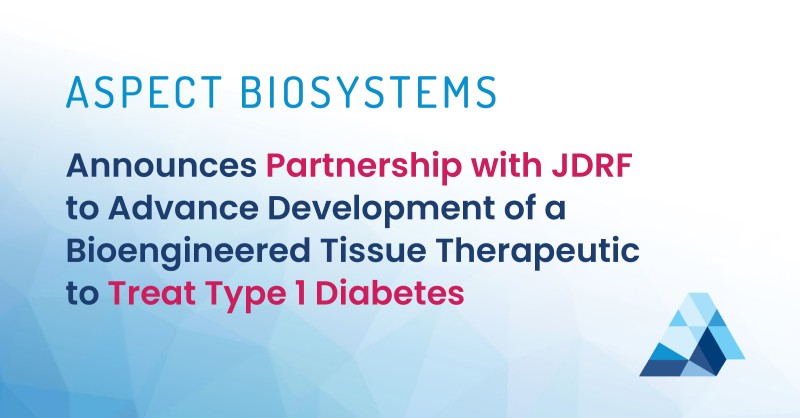Canadian biotech startup Aspect Biosystems, founded and led by biomedical engineer Tamer Mohamed, has partnered with the nonprofit organization Juvenile Diabetes Research Foundation (JDRF) to develop bioengineered tissue therapeutics to treat type 1 diabetes.
People with type 1 diabetes cannot produce insulin on their own, so they need to take it, either via injection or by using a pump, to survive. Either way, insulin is the essential treatment doctors employ worldwide to manage blood sugar in people with the disease. However, the goal of this new joint project is to transform how we treat the condition.
The partnership will allow Aspect to develop a bioengineered tissue therapeutic for type 1 diabetes that will provide insulin independence and control of blood sugar without the need for chronic immune suppression. In addition to funding, JDRF is also contributing strategic support through its deep expertise and vast network in the diabetes field.
For the task, Aspect is leveraging its proprietary bioprinting technology, therapeutic cells, and materials science to create a pipeline of cell-based tissue therapeutics that replace or repair damaged organ functions. These therapeutics are rationally engineered to be biologically functional, immune-protective, and suitable for surgical implantation to treat diseases such as type 1 diabetes.
JDRF’s Assitant VP of Research, Esther Latres, said the organization has led cell-based tissue therapy for more than 20 years.
“This funding partnership with Aspect Biosystems will support and continue scientific advancements in the field and undeniably take us closer to finding a cure,” noted Latres.
A very promising cure in sight
A spinoff out of the University of British Columbia (UBC), Aspect Biosystems made waves when it announced in 2013 that the company was ready to use live human cells to create and build living human tissue. Now described as a pioneering microfluidic bioprinting company, Aspect created its own bioprinting technology in which cells are combined and suspended in a liquid form hydrogel to create functional living human tissue models.
From its proprietary Lab-on-a-Printer technology, the startup created its flagship bioprinting system, the RX1, which relies on microfluidics to allow seamless cell and material patterning. Engineered to be compatible with a wide range of biomaterials, the bioprinter can help scientists create complex, functional tissue for research purposes.
But Aspect is not just about making bioprinters; the company leverages its technology to transform drug discovery and development as well as cellular therapy, aiming to treat various diseases, including diabetes. Targeting a middle ground in the broad space of bioprinting, just between cell-free, biocompatible implants and the creation of an organ, Aspect is working on taking its therapeutic tissues to the clinic to impact patients’ lives directly.
Up until now, its technology has been enabling advances in fundamental biology, drug development through novel pre-clinical models, and regenerative medicine, and this is the second time that Aspect has been involved in diabetes research and development.
With researchers from the University of Calgary, Aspect has developed a growing relationship to help their decades-long work of bioprinting living pancreatic tissues. In November 2021, this collaboration hit a milestone when Associate Professor Mark Ungrin and his lab in the University of Calgary’s Faculty of Veterinary Medicine (UCVM) developed human pancreatic islets—pseudoislets—to give them a better chance of survival when transplanted into people with type 1 diabetes.
Ungrin’s lab designed the pseudoislets as a way to package islet cells—typically found in the pancreas, where they regulate blood sugar levels—with controlled and reproducible size and improved survival and function both in culture and after transplant. The cell repackaging processes were then integrated into Aspect Biosystem’s work bioprinting pancreatic and other live tissues.
Later, at the International Pancreas and Islet Transplant Association (IPITA) conference, Aspect presented data highlighting the successful blood glucose regulation in animal models of type 1 diabetes for 90 days after implantation. The work helped advance Aspect’s bioprinted therapeutic program towards clinical evaluation, which could, ultimately, introduce a transformative cure for diabetic patients dependent on insulin injections.
This new partnership is rooted in the same desire to find a cure for type 1 diabetes. Like its previous collaborations, this study could have a radical impact as it lays the groundwork for future treatments and maybe even cures. The cell-therapy landscape is rapidly evolving, but one of the biggest challenges is still the technology and translation from the research lab to the clinic. Those are two significant hurdles that Aspect is trying to tackle.
Mohamed concluded: “Together with JDRF, we are aligned on the mission to develop a curative therapy for the millions of patients around the world who are affected by type 1 diabetes. This partnership will help advance our cutting-edge pancreatic tissue program and bring us a step closer to human trials.”
Subscribe to Our Email Newsletter
Stay up-to-date on all the latest news from the 3D printing industry and receive information and offers from third party vendors.
You May Also Like
3D Printing Unpeeled: New Arkema Material for HP, Saddle and Macro MEMS
A new Arkema material for MJF is said to reduce costs per part by up to 25% and have an 85% reusability ratio. HP 3D HR PA 12 S has been...
3D Printing News Briefs, January 20, 2024: FDM, LPBF, Underwater 3D Printer, Racing, & More
We’re starting off with a process certification in today’s 3D Printing News Briefs, and then moving on to research about solute trapping, laser powder bed fusion, and then moving on...
3D Printing Webinar and Event Roundup: December 3, 2023
We’ve got plenty of events and webinars coming up for you this week! Quickparts is having a Manufacturing Roadshow, America Makes is holding a Member Town Hall, Stratafest makes two...
Formnext 2023 Day Three: Slam Dunk
I’m high—high on trade show. I’ve met numerous new faces and reconnected with old friends, creating an absolutely wonderful atmosphere. The excitement is palpable over several emerging developments. The high...

































